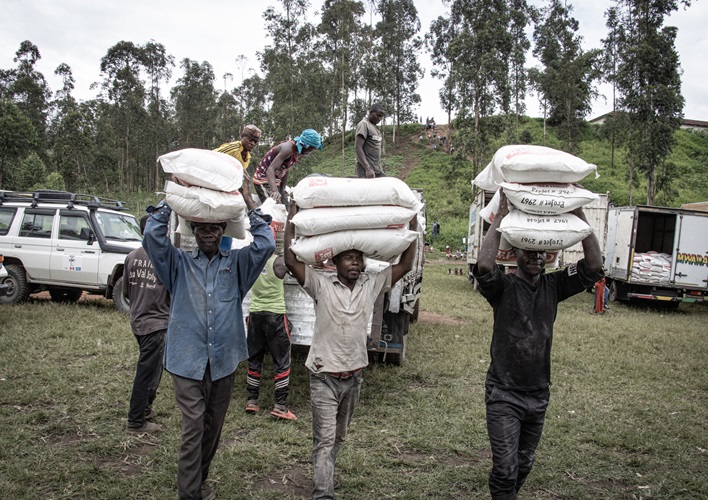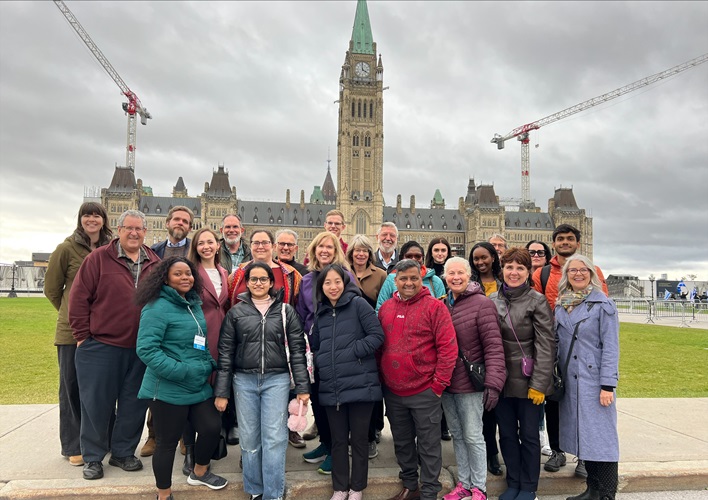Canadian farmers and rural communities have been helping end global hunger through growing projects for 30 years. (Photo: Submitted)
When Nathan Tollenaar moved to Stonewall, Manitoba from Listowel, Ontario, he was surprised there wasn’t already a Foodgrains Bank growing project in the area.
“I grew up with growing projects around home, and as long as I can remember, we’ve always had a growing project.”
So, “along with two other local farmers that I go to church with we decided to kickstart our own project,” says the 22-year old farmer, who studies at the University of Guelph.
With that, the Rock Solid growing project was born.
New Life Baptist church held a Christmas offering to help the project raise start-up costs. After a few challenges in obtaining appropriate land, they grew their first crop together—130 acres of canola—in 2018.
The Rock Solid project is one of the newest growing projects across Canada that is making a difference for people experiencing the scourge of hunger around the world.
The projects have a long and rich history, though.
2019 marks the 30th anniversary of the growing project movement, a movement where Canadian farmers, supporters, and even churches and community groups come together to grow a crop in support of ending global hunger. (Editors note: if you know of a growing project started prior to 1989, please contact the Foodgrains Bank to let us know.)
Growing projects weren’t always part of the Foodgrains Bank; when it started in 1983, grain was donated by individual farmers through grain drives—special days when farmers came together to deliver donated grain at local elevators.
Grain drives were made possible through a special arrangement with the Canadian Wheat Board, which permitted farmers to deliver grain outside of the quota system to Wheat Board facilities. The first grain drive was in Rosenort, Manitoba in 1976.
The idea quickly spread to other provinces. Each fall and winter, farmers and other volunteers would unload, clean and bag donated grain, then load it into railway cars for shipment overseas.
In the late 1980s, when the Wheat Board decided to let farmers deliver grain for the Foodgrains Bank directly into the system, the need for special drives disappeared. This made it easier for farmers to donate grain, but it eliminated the community nature of giving on a special day—something that many people missed.
In 1989, people in two communities thousands of kilometers apart independently came up with a new way of raising funds that promoted that sense of community spirit—growing projects.
One of those communities was Carrot River, Saskatchewan. That’s where local farmers decided to do something together to help people who were hungry.
The idea arose after local farmer Herman Enns returned home from a Mennonite Central Committee short-term service trip to Nicaragua.
While there, Enns—a Foodgrains Bank supporter—spotted a Foodgrains Bank grain bag in a widow’s house. Through an interpreter, he asked the family how the bag had come to be in that home; he was told they had received food during a time of great need.
Upon return home, Enns, made a number of presentations about his trip, always showing a photo of the grain bag.
“I showed it because it was of interest to me,” he says. “I had no idea what it would lead to.”
After a presentation at a church in nearby Nipawin, where Enns challenged people to think of what they could do to help people in need, local farmer John Fehr offered a quarter section of land on his farm to grow wheat for the Foodgrains Bank.
“That was something new,” says Enns, of the offer, adding that it was also a new idea for the Foodgrains Bank.
He accepted the generous offer, and soon others were involved—Glen Bartel planted the wheat, John Enns donated the seed, the fertilizer was donated by Gates Fertilizer, and the land was cultivated by Ernie Bitner.
“That fall we harvested 6,000 bushels of hard red spring wheat,” recalls Enns. “God blessed the project, and willing volunteers made it possible.”
That same year, and over 2,500 kilometers away in Paisley, Ont., a United Church pastor was looking for a way to involve members of his congregation in helping people who didn’t have enough to eat.
Today Mervyn Russell, then the Minister at the Paisley United Church, can’t recall exactly where the idea for a growing project came from. But he remembers being inspired by a presentation by church member Marilyn Coffman, who had volunteered to help as a nurse in Ethiopia.
“As she shared her experience, many of us were inspired to do something to help people who were starving,” he says.
Together with church members, they planted 20 acres of oats and barley on the farm of church member Jack Riley. “It was a good and simple way to help,” says Riley, now retired from farming. “At that time, we had so much food, and people were starving. It just seemed right to do something.”
Adds Russell, who is also now retired: “It was something we could do as a church. Being rural, we were well positioned for it. It was a way to use our resources and abilities to help others.”
After operating for a number of years, the growing projects in Carrot River and Paisley both came to an end. But they left behind a tremendous legacy; the idea that farmers could work together to grow and sell a crop is a key way hundreds of thousands of hungry people each year receive life-giving assistance.
“There are some things in life you feel particularly proud of—this is one of them,” says Russell. “Not only did we produce crops and money, but we also promoted understanding of the issue of hunger.”
“My aim in life is to serve Jesus, be it in faraway places or at home,” says Enns of his role in helping to start growing projects. “All I can say is ‘to God be the glory.’
–Amanda Thorsteinsson, with files from Shaylyn McMahon, Rick Block and John Longhurst




